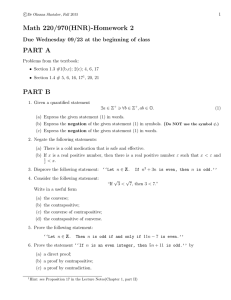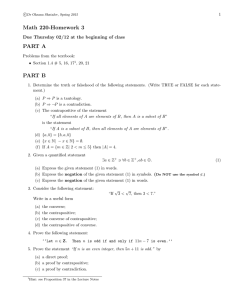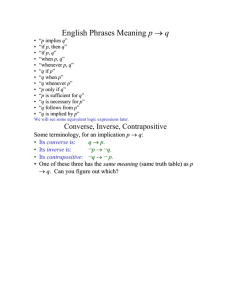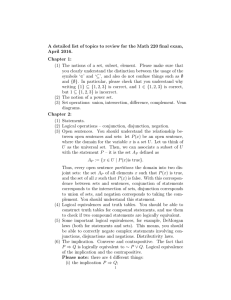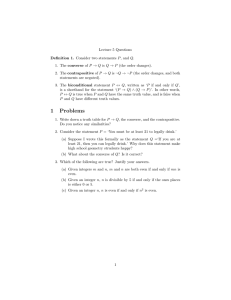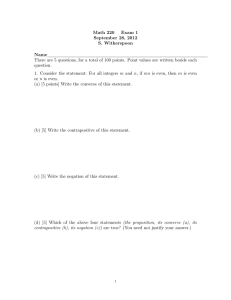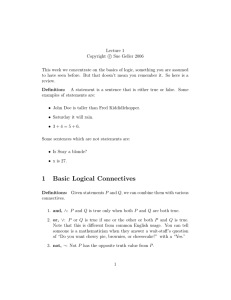A more detailed list of topics to review for the... Section 203 final exam, April 2016. Chapter 1:
advertisement
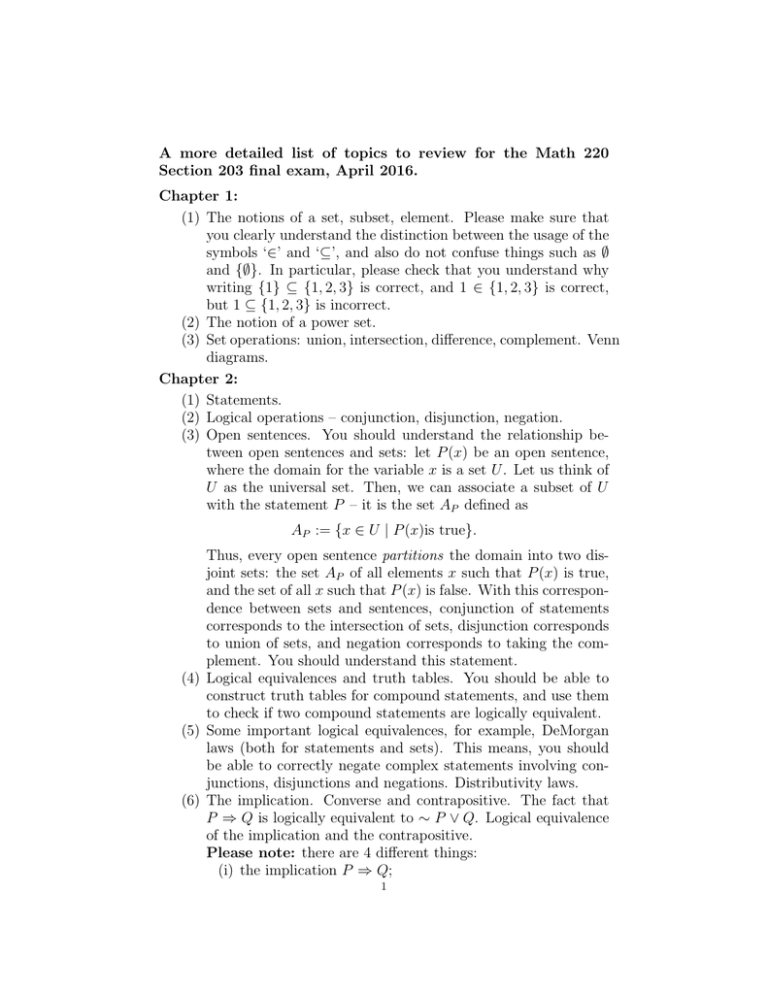
A more detailed list of topics to review for the Math 220
Section 203 final exam, April 2016.
Chapter 1:
(1) The notions of a set, subset, element. Please make sure that
you clearly understand the distinction between the usage of the
symbols ‘∈’ and ‘⊆’, and also do not confuse things such as ∅
and {∅}. In particular, please check that you understand why
writing {1} ⊆ {1, 2, 3} is correct, and 1 ∈ {1, 2, 3} is correct,
but 1 ⊆ {1, 2, 3} is incorrect.
(2) The notion of a power set.
(3) Set operations: union, intersection, difference, complement. Venn
diagrams.
Chapter 2:
(1) Statements.
(2) Logical operations – conjunction, disjunction, negation.
(3) Open sentences. You should understand the relationship between open sentences and sets: let P (x) be an open sentence,
where the domain for the variable x is a set U . Let us think of
U as the universal set. Then, we can associate a subset of U
with the statement P – it is the set AP defined as
AP := {x ∈ U | P (x)is true}.
Thus, every open sentence partitions the domain into two disjoint sets: the set AP of all elements x such that P (x) is true,
and the set of all x such that P (x) is false. With this correspondence between sets and sentences, conjunction of statements
corresponds to the intersection of sets, disjunction corresponds
to union of sets, and negation corresponds to taking the complement. You should understand this statement.
(4) Logical equivalences and truth tables. You should be able to
construct truth tables for compound statements, and use them
to check if two compound statements are logically equivalent.
(5) Some important logical equivalences, for example, DeMorgan
laws (both for statements and sets). This means, you should
be able to correctly negate complex statements involving conjunctions, disjunctions and negations. Distributivity laws.
(6) The implication. Converse and contrapositive. The fact that
P ⇒ Q is logically equivalent to ∼ P ∨ Q. Logical equivalence
of the implication and the contrapositive.
Please note: there are 4 different things:
(i) the implication P ⇒ Q;
1
2
(ii) the converse Q ⇒ P ;
(iii) the contrapositive ∼ Q ⇒∼ P ; and
(iv) the negation of the implication itself, ∼ (P ⇒ Q).
Of these, only the implication (i) and its contrapositive (iii)
are logically equivalent. Otherwise, none of these implies the
other. In particular, if P ⇒ Q is true, it does not at all mean
that the converse should be true (see if you can come up with
examples). The negation of the implication ∼ (P ⇒ Q) is
logically equivalent to ∼ (∼ P ∨ Q) ≡ P ∧ ∼ Q. In particular,
please do not confuse this with the contrapositive or converse,
or the contrapositive to the converse (which is a very popular
mistake – write down the contrapositive to the converse, and
you will see why). You should be able to come up with verbal
examples, such as “if I do not buy a lottery ticket, I will not
win the lottery”. Try making the converse, contrapositive, and
the negation of this statement, and look at the differences.
(7) The biconditional.
(8) Quantifiers. Unions and intersections (and complements) of
indexed unions of sets. Negation of statements involving quantifiers.
Chapter 3:
(1) Direct proof
(2) Proof by contrapositive
(3) Disproving statements by a counterexample.
You need to know when it is appropriate to use an example
to prove or disprove a statement. (If you are using an example
to disprove a statement, it is called counterexample). Look at your
Midterm 1 to check if you made a mistake in Problem 2, and make
sure you do not make such mistakes again.
Chapter 4:
(1) Basic proofs involving sets (Section 4.4). You need to know the
definitions: for example, what does it mean that A ⊆ B? Or
how to prove that two sets A and B are equal? (you need to
prove both inclusions A ⊆ B and B ⊆ A).
(2) Basic properties of set operations (Section 4.5); DeMorgan laws
for sets.
(3) Cartesian products of sets (section 4.6). For example, you need
to feel comfortable with the following definition: let A1 , . . . An
be sets. Then A1 ×A2 ×· · ·×An is the set of n-tuples of elements
3
(a1 , . . . an ) with a1 ∈ A1 , . . . , an ∈ An ; in other words,
A1 × A2 × · · · × An = {(a1 , . . . an ) : ai ∈ Ai for 1 ≤ i ≤ n}.
(Make sure you understand all the notation in this definition).
Chapter 5:
(1) Proof that a statement is false by means of a counterexample.
(section 5.1).
(2) Proof by contradiction (Sections 5.2-5.3). In particular, proof
by contradiction can include proofs involving rational/irrational
numbers.
(3) You need to know how to prove that there are infinitely many
prime numbers.
Chapter 6:
(1) The notion of a well-ordered set (you need to know the definition
and be able to come up with examples of sets that are wellordered and not well-ordered). (section 6.1)
(2) You need to know and understand the statements of the wellordering axiom for N and of the principle of mathematical induction (along with its variations such as strong induction).
(3) You need to be able to prove various statements using induction
or strong induction. The types of statements include: formulas
for sums; inequalities; statements about divisibility or congruence; statements about sets (such as the cardinality of the set of
all subsets of a given set); recursively defined sequences; graph
theoretic properties. This is the material in Sections 6.2 and
and 6.4, but please also look at your lecture notes and the workshops.
Section 8.1 and Chapter 9:
(1)
(2)
(3)
(4)
The definition of a relation (it is a subset of A × B).
The formal definition of a function. Domain and range.
The notion of injective, surjective and bijective function.
Image and inverse image (pre-image) of a set under a function.
Chapter 10:
(1) Basic concepts: the definition of |A| ≤ |B| and |A| = |B|. The
notion of a denumerable set, countable set and uncountable set.
(2) The proof that the union of finitely many denumerable sets is
denumerable.
(3) The proof that the union of countably many denumerable sets
is denumerable.
4
(4) The proof that a direct product of denumerable sets is denumerable (including the proof that N × N is denumerable).
(5) The proof that Q is denumerable.
(6) The fact that, for any set A, |A| < |P(A)| (without proof).
(7) The proof that the set P(N) is uncountable.
(8) The statement of the Cantor-Bernstein Theorem (without proof).
(9) The proof that any interval of real numbers which contains more
than a single element is uncountable.
(10) The proof that for any interval (a, b), |(a, b)| = |R| (need to
know how to construct an explicit bijection).
Graph theory:
(1) The definition of a simple graph.
(2) Basic facts about simple graphs. For example: the fact that the
number of edges is half the sum of the degrees of its vertices,
the corollary that the sum of the degrees of the vertices in a
graph has to be even, and the reformulation of this statement
as saying that a graph cannot have an odd number of vertices
of odd degree.
(3) Connectedness properties of graphs, the notion of a path and
the notion of a connected component. For example, you should
be familiar with the fact that a connected graph has an Euler
tour (a cycle traversing each edge of the graph exactly once) if
and only if all its vertices have even degree, and has an Euler
walk (a path which traverses each edge exactly once) if and
only if it has no more than two (that is, 0 or 2) vertices of odd
degree.
(4) More advanced notions related to simple graphs. Graph homomorphisms and isomorphisms, graph colourings and the chromatic number, planarity and its consequences such as Euler’s
Formula and the Five Colour Theorem.
